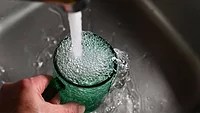EPA to Regulate Certain PFAS as Contaminants, Set Limits in Drinking Water

Credit: Unsplash via Pexels
A pre-publication draft of a final rule from the U.S. Environmental Protection Agency (EPA) has revealed EPA’s intent to regulate several types of per- and polyfluoroalkyl substances (PFAS) as contaminants, setting new maximum levels for six PFAS in drinking water.
In March 2021, EPA issued a determination to regulate perfluorooctanoic acid (PFOA) and perfluorooctane sulfonic acid (PFOS) as contaminants under the Safe Drinking Water Act (SDWA). EPA is now issuing a determination to regulate perfluorohexane sulfonic acid (PFHxS), hexafluoropropylene oxide dimer acid (HFPO-DA) and ammonium salt (also known as a GenX chemicals), perfluorononanoic acid (PFNA), perfluorobutane sulfonic acid (PFBS), and mixtures of these PFAS as contaminants under SDWA. The agency is also proposing a National Primary Drinking Water Regulation (NPDWR) and health-based Maximum Contaminant Level Goals (MCLG) for the four newly regulated PFAS and their mixtures, as well as for PFOA and PFOS.
EPA is proposing to set the MCLG for PFOA and PFOS at zero. Considering feasibility, including currently available analytical methods to measure and treat these chemicals in drinking water, EPA is proposing individual MCLs of 4.0 nanograms per liter (ng/L) or parts per trillion (ppt) for PFOA and PFOS.
The agency is proposing to use a Hazard Index (HI) approach to protecting public health from mixtures of PFHxS, HFPODA and its ammonium salt, PFNA, and PFBS because of their known and additive toxic effects, and their occurrence and likely co-occurrence in drinking water. EPA is proposing an HI of 1.0 as the MCLGs for the four PFAS, as well as any mixture containing one or more of the chemicals, because it represents a level at which no known or anticipated adverse effects on the health of persons is expected to occur and allows for an adequate margin of safety. EPA has determined it is also feasible to set the MCLs mixture containing one or more of PFHxS, HFPO-DA and its ammonium salt, PFNA, and PFBS for these four PFAS as an HI of 1.0.
The agency is requesting comment on this action, including this proposed NPDWR and MCLGs, and have identified specific areas where public input will be helpful for EPA in developing the final rule. In addition to seeking written input, the EPA will be holding a public hearing on May 4, 2023.
Interested stakeholders will be able to send comments, identified by Docket ID No. EPA-HQ-OW-2022-0114, by any of the following methods:
- Federal eRulemaking Portal
- Mail: U.S. Environmental Protection Agency, EPA Docket Center, Office of Ground Water and Drinking Water Docket, Mail Code 2822IT, 1200 Pennsylvania Avenue NW, Washington, DC 20460
- Hand Delivery or Courier: EPA Docket Center, WJC West Building, Room 3334, 1301 Constitution Avenue, NW, Washington, DC 20004.
Update, March 16, 2023: EPA has made an announcement with the following additional information:
EPA will be holding two informational webinars about the proposed PFAS NDPWR on March 16, 2023, and March 29, 2023. The webinars will be similar, with each intended for specific audiences. Registration is required to attend. The webinar recordings and presentation materials will be made available following the webinars at this website. For questions related to the public webinars, contact PFASNPDWR@epa.gov.
- March 16, 2023 (2:00-3:00 P.M. ET) Webinar Registration: General Overview of Proposed PFAS NPDWR
- March 29, 2023 (2:00-3:00 P.M. ET) Webinar Registration: Technical Overview of Proposed PFAS NPDWR
EPA will also be holding a public hearing on May 4, 2023, where members of the public can register to attend and provide verbal comments to EPA on the rule proposal. Registration is required to attend and the last day to register to speak at the hearing is April 28, 2023. For questions related to the public hearing, contact PFASNPDWR@epa.gov.
Looking for quick answers on food safety topics?
Try Ask FSM, our new smart AI search tool.
Ask FSM →








